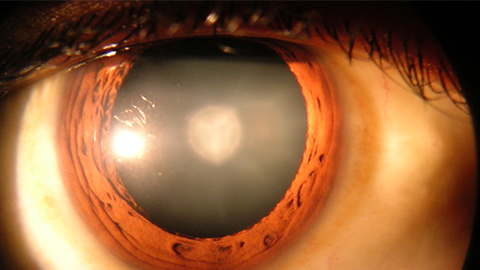Cataract Awareness Month
The World Health Organization, through education and advocacy, champions better vision at a global scale. Cataracts are among the WHO’s high-priority eye diseases. As such, June is Cataract Awareness Month.
Cataracts affect the lens of the eye and result in blurred vision. By the WHO's measure, they cause 51% of cases of blindness worldwide.
There are several forms of cataracts, including nuclear, cortical, posterior subcapsular and congenital. The first three are defined by the region of the lens affected, but all forms result in clouding. Congenital cataracts are present at birth and may require immediate surgery.
Nuclear cataracts, typically seen with aging, are the most common form. They create a hardening in the core region, the nucleus, of the lens and lead to decreased vision. Cortical cataracts create a glare, and posterior subscapular cataracts — the swiftest to develop — complicate seeing in bright light.
There are many risk factors and causes for developing cataracts. Aging is the main contributor, but cataract development is influenced by any combination of genetics, radiation exposure, blunt trauma, lifestyle and environment. Comorbidities, including hypertension and diabetes mellitus, increase the risk and — while the jury is still out on whether or not alcohol consumption increases the risk — smoking cigarettes nearly doubles it. Cataracts caused by underlying medical conditions, such as diabetes, or pharmaceuticals, such as like steroids, are called secondary cataracts.
Diagnosing cataracts begins with a visit to an ophthalmologist, who assesses the patient’s medical history and performs a number of comprehensive exams. Clouded or blurred vision, light sensitivity or difficulty driving at night dictate pertinent diagnostic tests. Common tests include retinal and slit-lamp exams and visual acuity tests.
For cataract prevention, the WHO encourages limiting sun exposure and UV radiation, quitting smoking, and maintaining or improving fitness.
If diagnosed at an early stage, glasses can help. However, after cataracts have fully formed, surgery is necessary. Surgery is typically safe and, with a 95% success rate, effective: It works by removing the cataract and replacing it with an intraocular lens.
There are cultural, geographical and financial barriers to diagnosing and treating cataracts. Not all those affected have the access or means for cataract diagnoses and treatments, which is why the WHO is working to improve medical accessibility for better vision.
Below are eye health research highlights from ASBMB journals.Age is linked to cataracts. But how?
Unlike our evershedding skin cells, lens cells have a low turnover rate. They accumulate damage over time, resulting in compositional changes. Jane Deeley and colleagues in 2010 used mass spectrometry to study changes to sphingomyelin in lenses from men ranging in age from 23 to 70. Read the paper in the Journal of Lipid Research.
Disulfide exchange in a crystallin protein in the human eye lens
Crystallin contributes to the gel-like substance of the lens responsible for refracting light. However, as the lens ages and damage accumulates, crystallin begins forming disulfide bonds where they don’t belong, leading to stiffness. Eugene Serebryany and colleagues studied protein-binding activity in crystallin molecules and found it to be a dynamic process — the disulfide bonds are shuttled from one crystallin molecule to the next until reaching a variant unstable enough to bind. Normal crystallin molecules continue passing the disulfide bond among themselves, but if a crystallin in this “hot potato” toss is even slightly damaged it will clutch on. These heterogenous crystallin molecules are more prone to aggregating than homogeneous, healthy variants and lead to cataracts. The authors believe if this process can be alleviated then, perhaps, so too can cataracts. You can find the original paper in the Journal of Biological Chemistry and an interview with its authors in ASBMB Today.
Cataract lens fiber cells lack transcriptional heterogeneity
Another team of researchers, led by Suraj P. Bhat, studied single-cell gene activity in lamellar cataracts, the most common form of bilateral childhood cataracts, and found decreased heterogeneity in fiber cells’ gene expression. They used samples from a two-day-old mouse lens with a mutation in the HSF4 gene, which produces a heat-shock transcription protein that — after mutating or malfunctioning — is known to cause lamellar cataracts. Reduced HSF4 gene activity correlated with decreased cell differentiation. Understanding how HSF4 relates to developing lens cells is a jumping-off point for future studies. Read the paper in the Journal of Biological Chemistry.
Cell architecture and function
In a short review published in 2015 in the Journal of Biological Chemistry, Jason Lowery and colleagues covered the many roles of structural proteins in the cytoskeleton. Of the five types of intermediate filament proteins, Type III proteins are linked to cataracts. While Type III proteins can be found in an array of cell types, they are primarily responsible for developing intermediate filaments in neurons. Mutations lead to a variety of diseases, including cataracts. Further research on the role of intermediate filaments in cellular function is greatly needed.
Enjoy reading ASBMB Today?
Become a member to receive the print edition four times a year and the digital edition monthly.
Learn moreGet the latest from ASBMB Today
Enter your email address, and we’ll send you a weekly email with recent articles, interviews and more.
Latest in Science
Science highlights or most popular articles

Mining microbes for rare earth solutions
Joseph Cotruvo, Jr., will receive the ASBMB Mildred Cohn Young Investigator Award at the ASBMB Annual Meeting, March 7–10, just outside of Washington, D.C.

Fueling healthier aging, connecting metabolism stress and time
Biochemist Melanie McReynolds investigates how metabolism and stress shape the aging process. Her research on NAD+, a molecule central to cellular energy, reveals how maintaining its balance could promote healthier, longer lives.

Mapping proteins, one side chain at a time
Roland Dunbrack Jr. will receive the ASBMB DeLano Award for Computational Biosciences at the ASBMB Annual Meeting, March 7–10, just outside of Washington, D.C.

Exploring the link between lipids and longevity
Meng Wang will present her work on metabolism and aging at the ASBMB Annual Meeting, March 7-10, just outside of Washington, D.C.

Defining a ‘crucial gatekeeper’ of lipid metabolism
George Carman receives the Herbert Tabor Research Award at the ASBMB Annual Meeting, March 7–10, just outside of Washington, D.C.

The science of staying strong
Muscles power every movement, but they also tell the story of aging itself. Scientists are uncovering how strength fades, why some species resist it and what lifestyle and molecular clues could help preserve muscle health for life.


